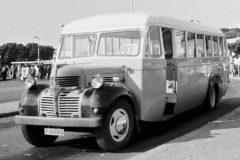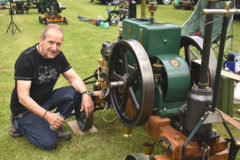Commer Fire Engines
Posted by Chris Graham on 27th March 2020
Commer Fire Engines
Ron Henderson tells us about the Rootes Group’s early post-war move into Commer Fire Engine market.
The forward control Commer QX chassis was the basis of one of the most popular fire engines of the early post-war era, with examples being operated by fire services throughout the United Kingdom, as well as overseas in countries ranging from Canada to Singapore, Africa, Australia and New Zealand.
In 1953, the Rootes Group produced a comprehensive brochure on Commer Fire Fighting Appliances (Tender, Pump and Pump Escape), fitted with OHV ‘under-floor’ engine developing 109bhp. The brochure listed 66 United Kingdom fire services that had ordered Commer fire engines so far, then went on to describe and illustrate some of the examples of bodywork styles that were available. Ten fire engines from five different body-builders were featured, all of them post-war newcomers to the fire engine scene, although they had historically been involved in making bodies for other commercial vehicles.
The bodybuilders
Alfred Miles & Sons, of Cheltenham, had three pages devoted to its Commer fire engines, all of the same design but with different equipment. First was a 400-gallon Fire Tender for Gloucestershire Fire Brigade – the prototype, in fact, which carried 400 gallons of water and a former war-time demountable pump, mounted at the rear, with facilities to tow a second one. Next was a 500gpm (gallons per minute) Fire Pump, of exactly the same design as the previous one, except that it had a built-in pump driven from the road engine, as well as the demountable pump.
The final one was an innovative fire engine of which Miles was a pioneer. This was a 500gpm Pump Escape; a development of the maker’s 500gpm Fire Pump, but equipped to carry a 50ft, wheeled escape ladder as well. All of these machines were constructed wholly of aluminium.
Hampshire Car Bodies Ltd, of Totton, also had three of its designs featured, with the same classifications and equipment as the Miles appliances. However, they had composite bodies, built with ‘well seasoned’ oak and ash framing, with exterior panelling of 18-gauge alloy. The examples illustrated were for Kent, Hertfordshire and Berkshire & Reading Fire Brigades.
Carmichael & Sons (Worcester) Ltd was featured twice, once with a 500gpm Fire Pump (basis of the famous Dinky Toys model) in East Riding of Yorkshire Fire Brigade livery and, secondly, with a similar design, but equipped to carry a 50ft wheeled escape ladder for Hampshire Fire Brigade.
These three fire engine coachbuilders, together with Dennis Bros, were the major competitors in the first two post-war decades and, subsequently, constructed many fire engines on Commer and other chassis, although all eventually closed down.
Flashes in the pan
The remaining two fire engine builders in the brochure were not so renowned, and didn’t stay in the fire engine business for long. Cuerdon Motors (Fire Tenders) Ltd Blackburn, was represented by a 900gpm fire pump for the West Riding of Yorkshire Fire Brigade, the biggest featured so far. The company went on to build fire engines for Lancashire, Suffolk & Ipswich, Portsmouth and Edinburgh, along with a few on Bedford chassis for Cambridge, plus a Leyland Comet for Halifax, then quietly faded away from the fire brigade scene.
Even more short-lived was EW Campion & Sons of Leicester, featured with an all-alloy 425gpm Fire Tender, with just a portable pump on the back. Some fire authorities preferred to order fire engines from local coachbuilders, to provide work for local industries, and Campion fulfilled this need for a short time, with only Leicester City and Leicestershire & Rutland Joint Fire Service ordering their engines.
The brochure was one of the most illustrative of the time, and depicted a range of classic vehicles from Britain’s motor and bodybuilding industries. This would not be unusual now, but the Rootes Group and Commer are no more, and none of the five fire engineering bodybuilders featured are still in existence, either. Campion and Cuerdon built fire engines for only a few years during the 1950s, while the other three bodybuilders produced a long line of fire engines on various chassis but, ultimately, also fell by the wayside. The question often asked is: “Where did it all go wrong?”
Ron Henderson tells the tale of the Rootes Group’s early post-war move into Commer Fire Engines market.

Carmichael’s offering for a wheeled escape-carrying appliance was a Hampshire Fire Brigade example which carried 120 gallons of water. This is the same model that was represented by the Dinky Toys Commer Fire Engine, except the back end is recessed to accommodate the cartwheels of the ladder carriage.
The forward control Commer QX chassis was the basis of one of the most popular fire engines of the early post-war era, with examples being operated by fire services throughout the United Kingdom, as well as overseas in countries ranging from Canada to Singapore, Africa, Australia and New Zealand.
In 1953, the Rootes Group produced a comprehensive brochure on Commer Fire Fighting Appliances (Tender, Pump and Pump Escape), fitted with OHV ‘under-floor’ engine developing 109bhp. The brochure listed 66 United Kingdom fire services that had ordered Commer fire engines so far, then went on to describe and illustrate some of the examples of bodywork styles that were available. Ten fire engines from five different body-builders were featured, all of them post-war newcomers to the fire engine scene, although they had historically been involved in making bodies for other commercial vehicles.

The cover of the Commer Fire-Fighting Appliances brochure, showing a Carmichael-bodied Commer of the City of Nottingham Fire Brigade. This was a very popular appliance in the 1950s.
The bodybuilders
Alfred Miles & Sons, of Cheltenham, had three pages devoted to its Commer fire engines, all of the same design but with different equipment. First was a 400-gallon Fire Tender for Gloucestershire Fire Brigade – the prototype, in fact, which carried 400 gallons of water and a former war-time demountable pump, mounted at the rear, with facilities to tow a second one. Next was a 500gpm (gallons per minute) Fire Pump, of exactly the same design as the previous one, except that it had a built-in pump driven from the road engine, as well as the demountable pump.

This photo shows the actual vehicle used in the brochure to illustrate the Alfred Miles 500gpm Pump Escape, but with the background masked out. The prototype, it was the first of 10 delivered to Northumberland County Fire Brigade, and a worthy tribute to the makers, as it was in front line service at the same fire station for 23 years.

This Alfred Miles-built, all-aluminium, 400-gallon Fire Tender was the prototype Alfred Miles appliance, built at the request of the Chief Fire Officer of Gloucestershire Fire Brigade, which led to a long line of similar appliances, also built on Bedford and Dennis chassis.
The final one was an innovative fire engine of which Miles was a pioneer. This was a 500gpm Pump Escape; a development of the maker’s 500gpm Fire Pump, but equipped to carry a 50ft, wheeled escape ladder as well. All of these machines were constructed wholly of aluminium.

This is the actual Hampshire Car Bodies 400-gallon Fire Tender that featured in the brochure. Once a regular visitor at rallies in the south of the country following withdrawal from service, it’s not certain whether this one still survives.

Also from Hampshire Car Bodies was this smart 500gpm Pump Escape, carrying a 50ft Merryweather wheeled escape ladder, for Berkshire & Reading Fire Brigade. Unlike the Alfred Miles example featured in the catalogue, this one carried only 100 gallons of water, compared with the 400 gallons of the Miles machine.
Hampshire Car Bodies Ltd, of Totton, also had three of its designs featured, with the same classifications and equipment as the Miles appliances. However, they had composite bodies, built with ‘well seasoned’ oak and ash framing, with exterior panelling of 18-gauge alloy. The examples illustrated were for Kent, Hertfordshire and Berkshire & Reading Fire Brigades.
Carmichael & Sons (Worcester) Ltd was featured twice, once with a 500gpm Fire Pump (basis of the famous Dinky Toys model) in East Riding of Yorkshire Fire Brigade livery and, secondly, with a similar design, but equipped to carry a 50ft wheeled escape ladder for Hampshire Fire Brigade.

The brochure’s Cuerden 900 gpm Fire Pump was represented by an example from the West Riding of Yorkshire Fire Brigade. An unusual feature of the Cuerden machines was that the hose reels were situated inside the cab, with the nozzle accessible from behind the cab door. (Ian Moore)
These three fire engine coachbuilders, together with Dennis Bros, were the major competitors in the first two post-war decades and, subsequently, constructed many fire engines on Commer and other chassis, although all eventually closed down.
Flashes in the pan
The remaining two fire engine builders in the brochure were not so renowned, and didn’t stay in the fire engine business for long. Cuerdon Motors (Fire Tenders) Ltd, in Blackburn, was represented by a 900gpm fire pump for the West Riding of Yorkshire Fire Brigade, the biggest featured so far. The company went on to build fire engines for Lancashire, Suffolk & Ipswich, Portsmouth and Edinburgh, along with a few on Bedford chassis for Cambridge, plus a Leyland Comet for Halifax, then quietly faded away from the fire brigade scene.
Even more short-lived was EW Campion & Sons of Leicester, featured with an all-alloy 425gpm Fire Tender, with just a portable pump on the back. Some fire authorities preferred to order fire engines from local coachbuilders, to provide work for local industries, and Campion fulfilled this need for a short time, with only Leicester City and Leicestershire & Rutland Joint Fire Service ordering their engines.

An illustration from the brochure showing Campion’s contribution. The machine was for Leicester & Rutland Fire Service, and was finished in a dark maroon livery.
The brochure was one of the most illustrative of the time, and depicted a range of classic vehicles from Britain’s motor and bodybuilding industries. This would not be unusual now, but the Rootes Group and Commer are no more, and none of the five fire engineering bodybuilders featured are still in existence, either. Campion and Cuerdon built fire engines for only a few years during the 1950s, while the other three bodybuilders produced a long line of fire engines on various chassis but, ultimately, also fell by the wayside. The question often asked is: “Where did it all go wrong?”
To subscribe to Vintage Roadscene magazine, simply click here





